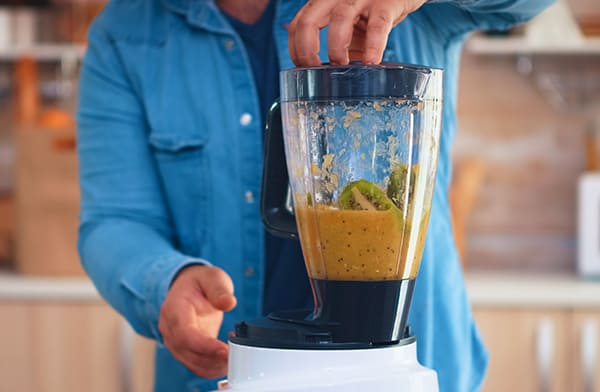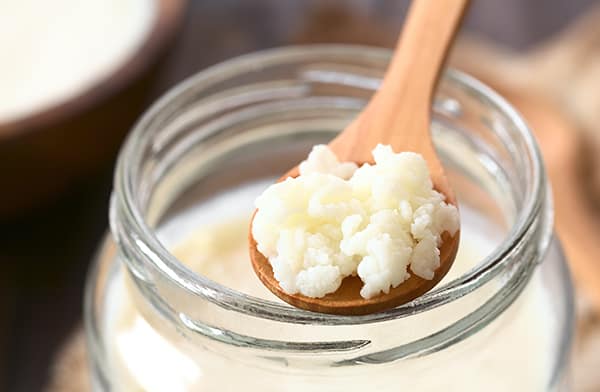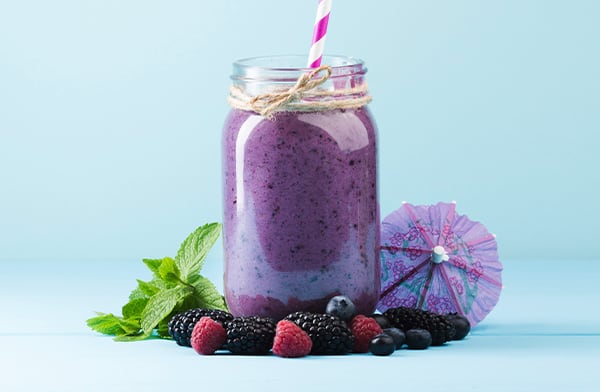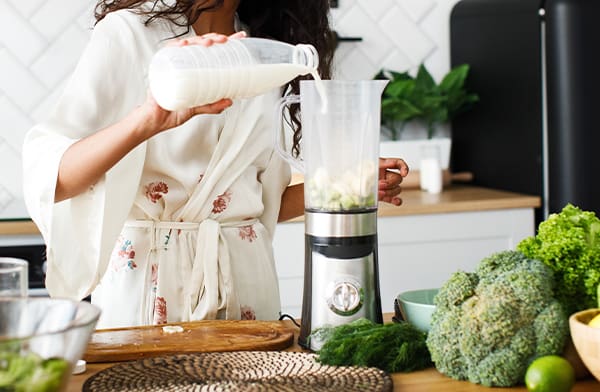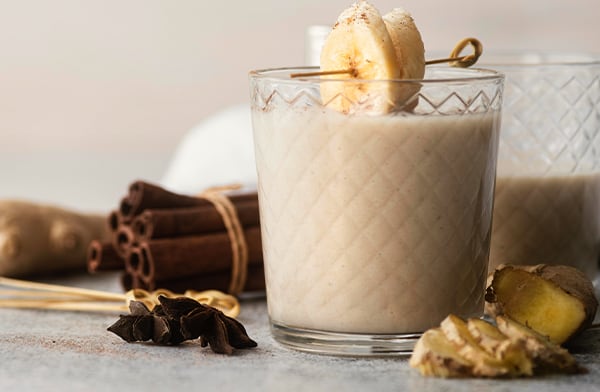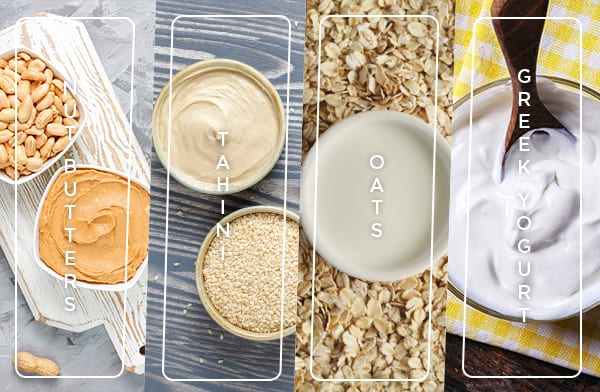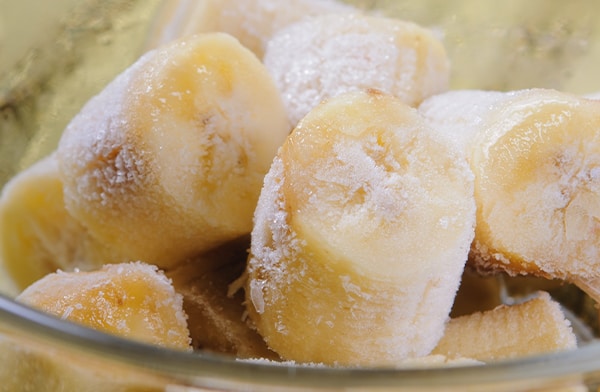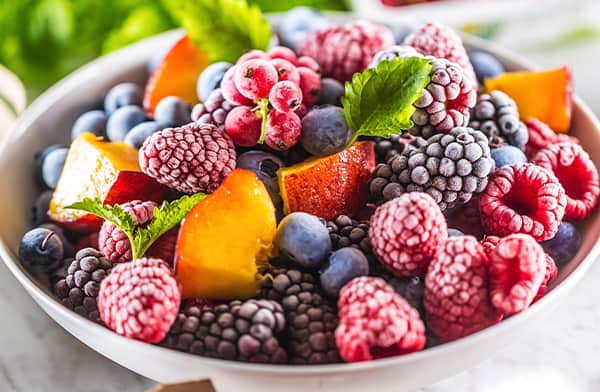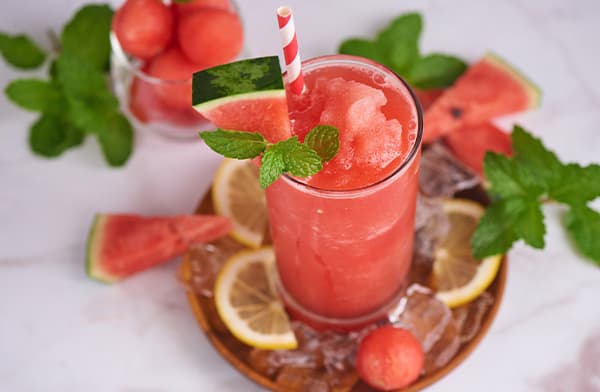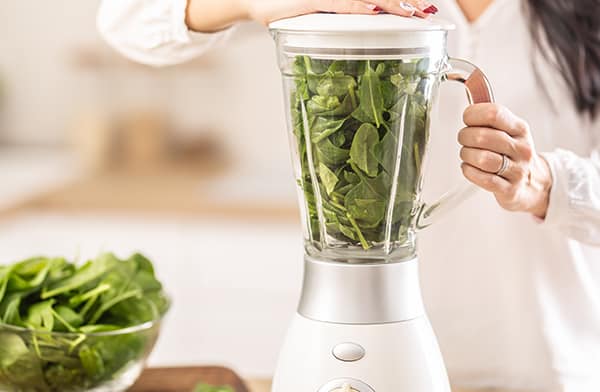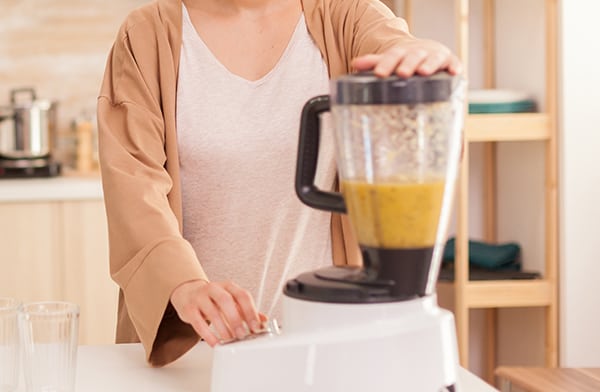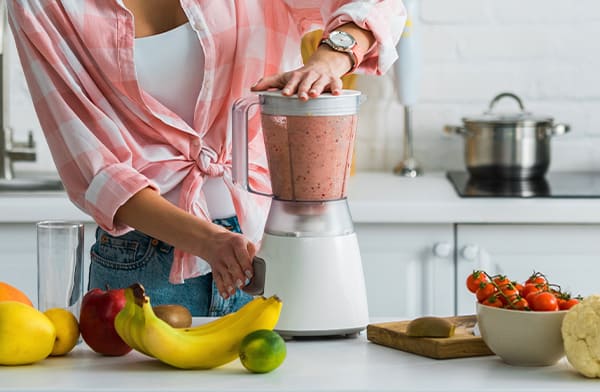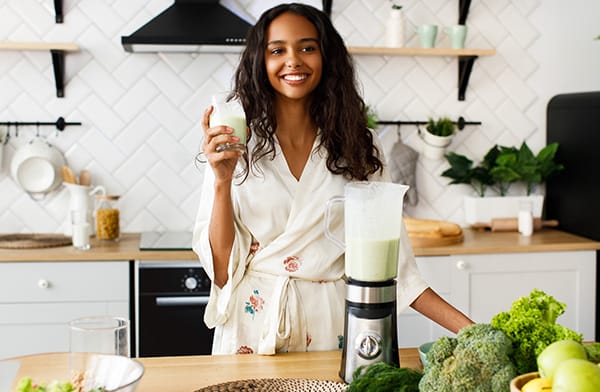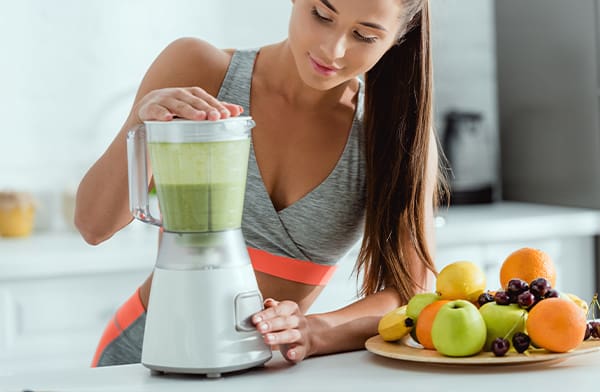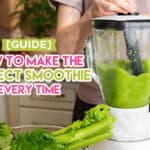FAQ: My Smoothie is Too Thin or Thick, What Should I Do?
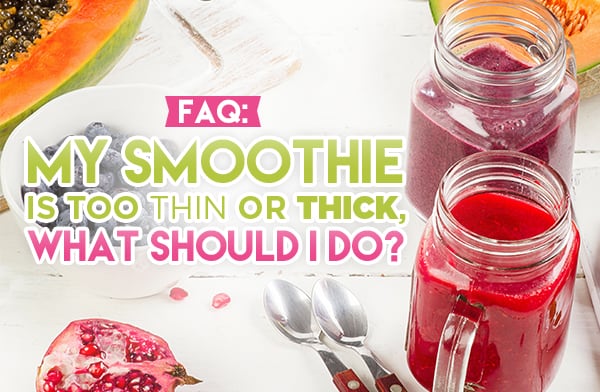
There’s no such thing as the perfect smoothie.
No single smoothie will be perfect for everyone. What you like might not be what I like, and what we like might not be what your buddy at the gym likes. Everyone has different preferences for texture, thickness, flavor, and temperature.
Part of a good smoothie diet is making smoothies you enjoy. So, what happens when the smoothie you make just isn’t where you want it? Maybe it’s too thick and you feel like you’re locked into eating it with a spoon. Perhaps it’s too thin and it just tastes like a weird, chunky juice. What can you do?
Luckily for you, I’ve got a bunch of tips to help with this problem. Just read on!
My Smoothie is Too Thick. What Do I Do?
When your smoothie is too thick, you need to thin it out. There are many different ways you can do this, but most are pretty simple: add a little splash of liquid or some extra ingredients to help loosen it up.
Blend It More
Some smoothies stay thick until they’re fully blended. This is especially true when you’re using frozen ingredients as a base, whether it’s plain old ice cubes, frozen juice, or frozen fruit. The coarser the grind of your frozen ingredients, the thicker the smoothie will be, at least until it all settles to room temperature.
Use Kefir Instead of Yogurt
Yogurt, especially Greek yogurt, is pretty thick. It’s great as a base for a fresh smoothie because it serves to thicken things up, but if you’re using frozen ingredients, the combination can be just a bit too thick to be pleasant or easy to drink. While you can always convert it into a smoothie bowl, another option is to use kefir instead of yogurt.
Kefir is a fermented milk drink, usually made from cow, goat, or sheep milk. It’s originally from the North Caucuses region of Eastern Europe but has spread around the world as a popular drink and probiotic. It’s creamy and tangy much like yogurt, but has a thinner consistency closer to milk, making it a great smoothie base.
Let It Warm Up a Little
Most smoothies have frozen ingredients as a base, whether it’s frozen banana, frozen berries, or even just ice cubes. As you probably know, when things are cold, they slow down. This is true at a molecular level and with people in general, so why wouldn’t it be true of a smoothie?
Think about ice cream. It’s thick and rich and creamy when it’s frozen, but as it thaws, it thins out. The same is true of smoothies. When you have frozen ingredients, they’ll not only be thick and slow to move, but they’ll chill your non-frozen ingredients and potentially even freeze them too.
The solution? Just let it warm up a bit! You can let it sit for a few minutes or you can partially thaw your frozen ingredients before using them. Just make sure to stir or re-blend the smoothie as you let it warm up, otherwise it might separate, and that’s a whole other problem.
Many articles recommend that you microwave your smoothie for a short while, but you should probably avoid this. It can change the consistency and taste of your smoothie for the worse, and you risk overdoing it. It’s better to warm it up by letting it sit on the counter until it’s thinned out.
Add a Bit of Liquid
Adding a liquid to thin your smoothie out a bit is the easiest way to do it. Just remember that adding some liquid will change the flavor as well as the texture. Water thins out the flavor. Milk makes it creamier but dulls down the more potent tangy or spicy flavors. Juice can add a bit of tang of its own, but it also adds a lot of sugar, making your smoothie less healthy.
On the plus side, you don’t need much to thin out a smoothie. Add a small splash or a tablespoon at a time and see how it mixes up. You can always add more liquid later, but you can’t remove it.
What Can I Do If My Smoothie Is Too Thin?
If your smoothie is too thin, you have to first figure out: is it actually too thin in texture, or is it too thin in flavor?
One of the biggest gripes with smoothies I see is people who make their smoothies with a ton of ice. Ice melts, especially when it’s mixed by a blender, and that leaves smoothies watery and thin in flavor.
Add Spice
A thin flavor might mean you’re using too many bland ingredients. This can be a particular problem if you’re buying fruit that’s out of season and isn’t very flavorful. Do you know what’s never out of season? Spice! It works well – try mixing in cinnamon, ginger, or even a tiny pinch of salt to bring more flavor to your smoothies.
If salt sounds like a strange addition, bear in mind that the main reason salt is used in everything is as a flavor enhancer. By adding a small pinch of salt (no more than 1/16th of a teaspoon), it can enhance the flavors of your smoothie without adding a taste of its own or significantly increasing your daily sodium intake.
Add Something Creamy
On the other hand, if the texture of your smoothie is too thin, you have a few different options you can try.
- Nut butters are a good option for a thick and creamy thickener. They tend to work best with sweet or green smoothies rather than tangy fruit and yogurt smoothies, but you can customize your blend however you like.
- Tahini, which is a paste made out of sesame seeds, is a very flavorful option for a thickener. Some people aren’t a fan of the taste of sesame, though, so make sure you like it before you try it.
- Oats can be a great thickener, but you need to prepare them ahead of time. You also don’t need very much! Oats need to be soaked to soften them before you can appropriately blend them up into a smoothie as a thickener.
- Greek yogurt can work well as a replacement for some water/juice/kefir as a base. It’s essentially the opposite as the solution listed above.
I’ve also seen people recommend adding tofu (specifically silken tofu), avocado, or cooked oatmeal as thickeners as well. These all work, but they have nutritional concerns that should be considered when using smoothies to lose weight. Avocado, for example, is delicious and packed with nutrients, but it also has a fair amount of calories.
Use Frozen Bananas as a Base
If you’re using something like yogurt or juice as a base and your smoothies consistently turn out too thin, why not consider using something like frozen bananas as your base instead? Bananas are great! Bananas can be blended into something that almost tastes like ice cream but is healthier, so of course, they’re going to be able to thicken up a smoothie. Plus, you can chop and freeze a banana into smaller pieces to make them easier and more convenient to add to your smoothie.
Frozen bananas can also be a flexible flavor base. Under-ripe bananas tend to have a more neutral, creamy flavor, though I’d avoid using fully green bananas. Also, if you let your bananas ripen considerably before freezing them, they’ll have a stronger and sweeter flavor. It’s all about when you freeze them.
Add More Frozen Fruit
Other frozen fruits can work as a base to thicken your smoothies as well. Berries are great, but they can leave bits of skin or seeds unblended in the smoothie, which isn’t everybody’s cup of tea. I’ve had good luck with frozen pineapple, and frozen mango can be delicious as well.
It all comes down to flavor profiles in the fruit you choose. What flavors are you going for? Give them a try and freeze them.
Chill It a Bit
Smoothies can freeze – that’s one way to store them for later – and freezing them will thicken them. Of course, a frozen smoothie is too thick to drink. So, what do you do?
Well, you can chill your smoothie for a bit before you drink it. Setting your smoothie in the freezer for 10-15 minutes will start to chill and thicken up your smoothie without fully freezing it (unless you have a blast freezer). It all depends on ambient temperature and composition, though, so pay attention to your smoothie and make sure you don’t over-chill it. Oh, and make sure to stir it up before you drink, in case it separated while you were chilling it.
How Can I Make My Smoothies Less Chunky?
One issue some people have with smoothies is ending up with a drink that’s a little bit too chunky to enjoy. If you’re getting bits of ice, frozen fruit, fruit skin, or unchopped greens clogging up your straw, well, that’s a problem, isn’t it? Luckily, you can deal with this problem fairly easily.
Blend Your Greens First
I highly recommend greens in most smoothies – you can read more about it here – but I fully admit that sometimes they can be a little unpleasant. Nothing gets in the way of enjoying a smoothie quite the same as sucking a big leaf chunk up through a straw, right?
You have two options here. The first is to add your liquid and greens, then pulse your blender to chop and puree the greens into a liquid before adding the other ingredients. You can even add your greens and puree them first or blend them in a food processor before adding them to your blender. It depends on what appliance you’re using.
The other option is to make sure you’re weighing down the greens in your blender. Add your liquid, then your greens, then your frozen ingredients, then the rest. This way, when your blender gets spinning, the heavier ingredients on top push the greens down lower into the blades.
Blend in Pulses and Stir
If you have an old blender or a blender that doesn’t properly form a vortex (more on that in a moment), you might need to pulse and stir. Pulse your blender to get some chopping action going, then stop to let the ingredients settle back down. Periodically take the lid off and stir everything up, and remember to scrape the sides of the blender to make sure that greens and bits of fruit aren’t stuck in there.
Most modern blenders don’t need this, but if you bought a cheap one or you’re using an old hand-me-down, you might run into this problem.
Start Slow, Then Increase
This section is where the vortex comes in. Modern blenders are designed so that it forms a vortex once the ingredients are mostly chopped up. It’s similar to how a drain creates a whirlpool when you pull the plug.
A blender does this through angles on the blades, as well as the shape of the cup. When the blades spin, they force blended ingredients up along the outside of the cup while pulling them down in the middle. This helps the ingredients circulate to make sure that they are thoroughly blended.
The key to this is to make sure you’re not pulsing! Start slow to chop up the larger ingredients, then increase speed to form the vortex. Blend for a couple minutes and your smoothie will end up perfectly smooth every time.
Get a Better Blender
Unfortunately, not all blenders are created equal. Some blenders, especially low-end or old blenders, can have issues with properly blending up a smoothie. Some are also not able to chop through solidly frozen food or ice as quickly. The blades on a blender will also wear out over time.
If you check out my program, in addition to recipes and ingredient lists, I also have a set of recommended blenders. They aren’t the only blenders you can buy, but they’re some of the best I’ve tried for a handful of different price ranges. It might just be time for a new blender!
Your Ideas
Have you had to deal with smoothies that are too thick or too thin? Have you come up with your own solutions I didn’t mention here? If so, let me know! I’d love to hear what you’ve come up with. And, if you have any other questions about getting the perfect smoothie going, you can let me know those as well. I’m always open to chatting with my followers and learning more about how we all enjoy our smoothies.


